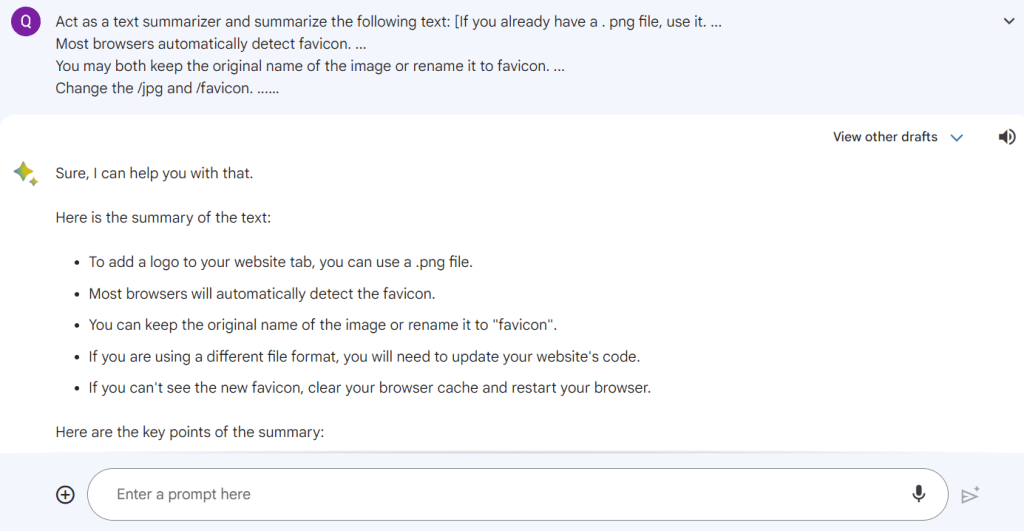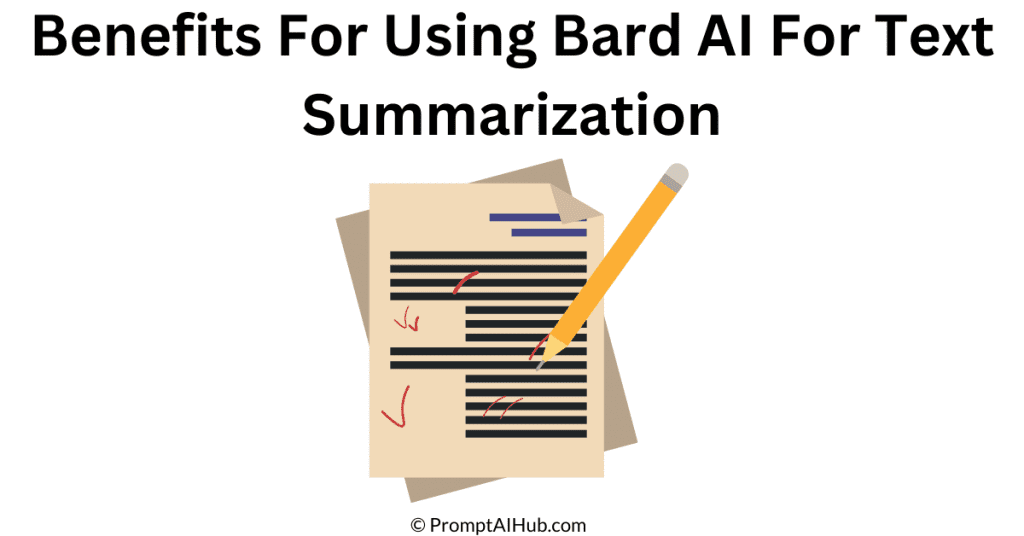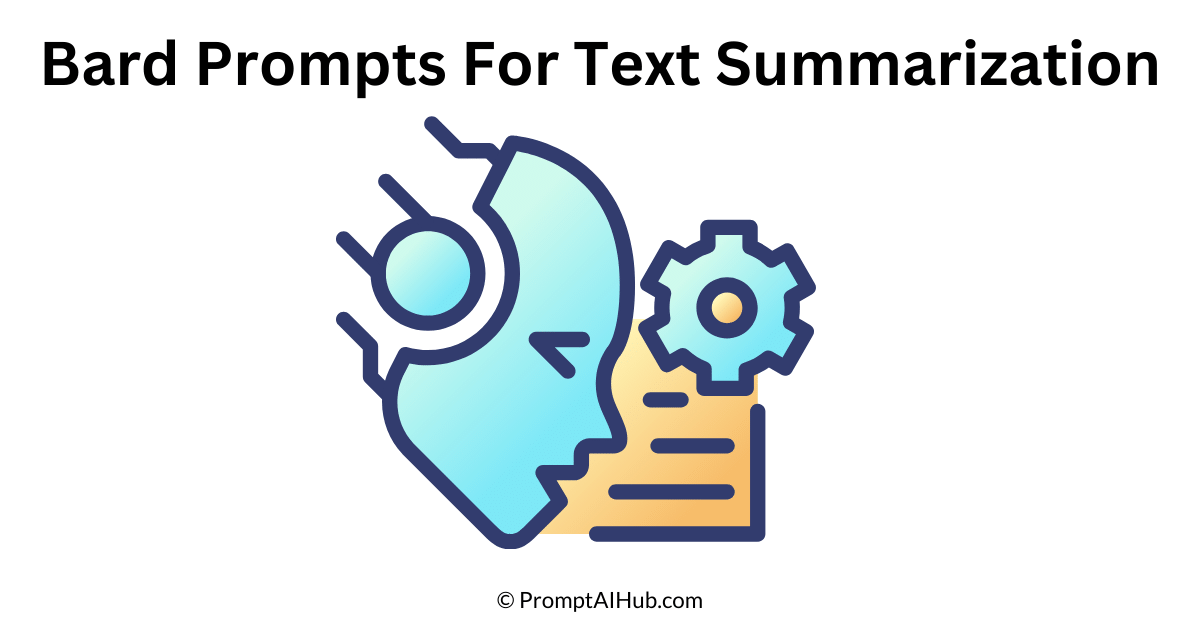Curious about leveraging Google’s powerful BERT models for text summarization but unsure where to start? Don’t worry, it’s not as complex as it might seem. By delving into this article, crafted with insights from Google Bard prompts, you’ll gain a practical understanding of how to harness these tools effectively. Whether you’re a seasoned professional or just exploring the potential, this read will equip you with the skills to maximize Google Bard for concise and impactful text summarization. So, if you’re serious about enhancing your summarization game, invest a few minutes here – you won’t regret it.
Single Prompt To Detailed Summarize The Text
Act as a text summarizer and provide a concise summary of the key points in the following text: [Insert your text here] The text discusses [topic], and I want the summary to capture these [important details] while summarizing. Please include the most crucial part that must be read and cannot be ignored. Additionally, write a brief 5-line summary at the end that encompasses all essential aspects of the topic according to the conditions.
Also: Effective Google Bard Prompts For Resume Writing
All 45 Prompts For Text Summarization
1. “Act as a text summarizer and summarize the following text: [Insert your text here] This text is about [topic] and I want you to include these [conditions] while summarizing.”

2. “Please provide a summary of the following text: [Insert your text here] The text discusses [topic], and I require you to consider [conditions] in the summary.”
3. “Generate a concise summary for this passage: [Insert your text here] In this text covering [topic], make sure to include [conditions] in your summary.”
4. “Summarize this document with the following constraints: [Insert your text here] The text pertains to [topic], and I’d like the summary to adhere to these [conditions].”
5. “Create a summary of this text while taking into account: [Insert your text here] This text is focused on [topic], and the summary should meet these specific [conditions].”
6. “As a text summarizer, please summarize the provided text: [Insert your text here] The content is about [topic], and I want you to consider [conditions] when creating the summary.”
7. “Generate a summary for this document: [Insert your text here] This document covers [topic], and I’d like the summary to incorporate [conditions].”
8. “Summarize the following text: [Insert your text here] It discusses [topic], and I want the summary to address these [conditions].”
9. “Please provide a brief summary of this passage: [Insert your text here] The passage focuses on [topic], and I need you to take into account these [conditions].”
10. “Create a concise summary for this content: [Insert your text here] The content is related to [topic], and I want the summary to reflect [conditions].”
Also: Best Free Chrome Extensions For Google Bard (Tried & Tested)
11. “Imagine you’re a text summarization expert. Summarize this text: [Insert your text here] It’s about [topic], and I want you to incorporate [conditions] into the summary.”
12. “In your role as a text summarizer, please summarize the provided content: [Insert your text here] This content pertains to [topic], and I need you to consider [conditions] in the summary.”
13. “Generate a summary for this article: [Insert your text here] The article discusses [topic], and I require the summary to include [conditions].”
14. “Create a brief summary for this document: [Insert your text here] The document is related to [topic], and I want the summary to meet [conditions].”
15. “Summarize this passage with the following constraints: [Insert your text here] The passage covers [topic], and I’d like the summary to adhere to these [conditions].”
16. “Please provide a summary of this text: [Insert your text here] It’s about [topic], and I want the summary to take these [conditions] into consideration.”
17. “Generate a concise summary for the following text: [Insert your text here] The text discusses [topic], and I need you to incorporate [conditions] in the summary.”
18. “Summarize the main points from this document: [Insert your text here] This document focuses on [topic], and I want the summary to reflect [conditions].”
19. “I need a summarized version of this passage: [Insert your text here] The passage is related to [topic], and I require you to address these [conditions].”
20. “Summarize the key information in this article: [Insert your text here] The article is about [topic], and I want you to include these [conditions] in the summary.”
Also: Comprehensive Google Bard Prompts For Questions
21. “Act as a text summarizer and provide a summary for the following text: [Insert your text here] This text is about [topic], and I need you to consider these [conditions] while summarizing.”
22. “Imagine you’re our text summarization coach. Summarize the text: [Insert your text here] It relates to [topic], and I want you to incorporate [conditions] into the summary.”
23. “In your role as an expert in text summarization, create a summarized version of this document: [Insert your text here] The document pertains to [topic], and I’d like the summary to adhere to these [conditions].”
24. “Generate a concise summary for this content: [Insert your text here] The content discusses [topic], and I require the summary to include [conditions].”
25. “Summarize the provided text while taking into account: [Insert your text here] The text is focused on [topic], and I want the summary to meet these specific [conditions].”
26. “As a text summarizer, please provide a summary for this document: [Insert your text here] This document covers [topic], and I need you to consider [conditions] when creating the summary.”
27. “Generate a summary for this article: [Insert your text here] The article discusses [topic], and I want the summary to reflect [conditions].”
28. “Summarize the following text: [Insert your text here] It’s about [topic], and I need the summary to address these [conditions].”
29. “Please provide a brief summary of this passage: [Insert your text here] The passage focuses on [topic], and I require you to take into account these [conditions].”
30. “Create a concise summary for this content: [Insert your text here] The content is related to [topic], and I want the summary to incorporate [conditions].”
Also: Unique Bard Prompts for Book Summary
31. “Imagine you’re a text summarization expert. Summarize this text: [Insert your text here] It’s about [topic], and I want you to incorporate [conditions] into the summary.”
32. “In your role as a text summarizer, please summarize the provided content: [Insert your text here] This content pertains to [topic], and I need you to consider [conditions] in the summary.”
33. “Generate a summary for this document: [Insert your text here] The document discusses [topic], and I require the summary to include [conditions].”
34. “Create a brief summary for this document: [Insert your text here] The document is related to [topic], and I want the summary to meet [conditions].”
35. “Summarize this passage with the following constraints: [Insert your text here] The passage covers [topic], and I’d like the summary to adhere to these [conditions].”
36. “Please provide a summary of this text: [Insert your text here] It’s about [topic], and I want the summary to take these [conditions] into consideration.”
37. “Generate a concise summary for the following text: [Insert your text here] The text discusses [topic], and I need you to incorporate [conditions] in the summary.”
38. “Summarize the main points from this document: [Insert your text here] This document focuses on [topic], and I want the summary to reflect [conditions].”
39. “I need a summarized version of this passage: [Insert your text here] The passage is related to [topic], and I require you to address these [conditions].”
40. “Summarize the key information in this article: [Insert your text here] The article is about [topic], and I want you to include these [conditions] in the summary.”
Also: How Google’s Bard AI is Trained?
41. “Act as a text summarizer and provide a summary for the following text: [Insert your text here] This text is about [topic], and I need you to consider these [conditions] while summarizing.”
42. “Imagine you’re our text summarization coach. Summarize the text: [Insert your text here] It relates to [topic], and I want you to incorporate [conditions] into the summary.”
43. “In your role as an expert in text summarization, create a summarized version of this document: [Insert your text here] The document pertains to [topic], and I’d like the summary to adhere to these [conditions].”
44. “Generate a concise summary for this content: [Insert your text here] The content discusses [topic], and I require the summary to include [conditions].”
45. “Summarize the provided text while taking into account: [Insert your text here] The text is focused on [topic], and I want the summary to meet these specific [conditions].”
46. “As a text summarizer, please provide a summary for this document: [Insert your text here] This document covers [topic], and I need you to consider [conditions] when creating the summary.”
47. “Generate a summary for this article: [Insert your text here] The article discusses [topic], and I want the summary to reflect [conditions].”
48. “Summarize the following text: [Insert your text here] It’s about [topic], and I need the summary to address these [conditions].”
49. “Please provide a brief summary of this passage: [Insert your text here] The passage focuses on [topic], and I require you to take into account these [conditions].”
50. “Create a concise summary for this content: [Insert your text here] The content is related to [topic], and I want the summary to incorporate [conditions].”
These prompts should help you instruct a text summarization model effectively while specifying the text, topic, and any conditions or instructions you have for the summary. Simply replace “[topic]” and “[conditions]” with your relevant text and instructions.
Also: Unique Google Bard Prompts for Social Media Ads
Benefits of Using Bard Prompts for Text Summarization

1. Enhanced Clarity and Brevity: Bard prompts simplify complex content, allowing for clearer and more concise summaries, which is crucial for effective communication in various domains.
2. Improved Information Retention: These prompts help readers and audiences retain key points and ideas, making them a valuable tool for knowledge transfer and learning.
3. Customized Summaries for Every Context: Bard prompts can be tailored to suit specific topics and industries, ensuring relevance and usefulness in any domain.
4. Engaging Content Creation: Bard prompts stimulate creativity, making it easier to craft engaging summaries that capture and hold the reader’s attention.
5. Time and Resource Efficiency: Utilizing Bard AI and prompts streamlines the summarization process, saving time and resources that can be invested elsewhere in your projects or endeavors.
Also: Google Bard Prompts for Teachers
Why Choose Bard AI For Text Summarization?
Harness the power of Bard AI for text summarization. With its advanced capabilities and customizable prompts, Bard AI simplifies complex content, ensuring clarity, retention, and engagement in diverse domains.
Visit Our Free AI tools
Prompts AI Hub Team Has Tailored Their AI Knowledge and Created Tools for You Free of Cost, Enjoy
Using Bard Prompts For Text Summarization (Quick Guide)
1. Identify the Content: First, carefully read or understand the content you want to summarize. Whether it’s an article, document, passage, or text, make sure you have a clear grasp of its main points and the topic it covers.
2. Determine the Conditions: Analyze the specific conditions or requirements mentioned in the prompts. These conditions could include things like the level of detail, the tone, the length of the summary, or any specific points or elements that must be included.
3. Customize the Prompt: Take one of the provided prompts and insert the relevant text from the content you want to summarize. Make sure to replace “[Insert your text here]” with the actual content you’re summarizing. For example, if summarizing an article about climate change, your prompt might look like this: “Generate a concise summary for this article: ‘The article discusses the impact of climate change on coastal cities, and I need the summary to include the key statistics and solutions.’”
4. Compose the Summary: Once you have your customized prompt, use it to generate a summary. You can use AI-powered tools, like GPT-3, to help you generate the summary based on the conditions you’ve specified. Review and edit the generated summary as needed to ensure it accurately captures the main points and adheres to the specified conditions.
5. Review and Refine: After generating the summary, review it to ensure it meets the conditions outlined in the prompt. Make any necessary revisions to improve clarity, coherence, or accuracy. Ensure that the summary effectively conveys the essential information from the original content.
By following these steps, you can effectively use the provided prompts to generate concise and tailored summaries of various types of content while adhering to specific conditions or requirements.
Download All Prompts
To Download 50K Plus Prompts Click Below and Get Them In One Click.
Final Thoughts
In conclusion, “Bard Prompts for Text Summarization” and the accompanying “Bard AI” represent a dynamic duo that can revolutionize the way we approach summarizing complex information. With benefits ranging from enhanced clarity and improved information retention to customization and resource efficiency, this combination is a powerful tool for professionals and learners alike. By harnessing the capabilities of Bard AI and leveraging its customizable prompts, individuals can navigate the challenges of text summarization across diverse domains with greater ease and effectiveness. Embracing Bard AI means embracing a future where information is simplified, engagement is heightened, and communication thrives.
Can Google Bard summarize text?
Yes, Google Bard can summarize text. It can do both extractive summarization, which selects the most important sentences from the text, and abstractive summarization, which generates new sentences that convey the same meaning as the original text.
How do you train a BERT for text summarization?
To train a BERT for text summarization, you need to first pre-train the BERT model on a large corpus of text. Once the BERT model is pre-trained, you can then fine-tune it on a dataset of text and summaries. This fine-tuning process will teach the BERT model to identify the important sentences in a text and to generate summaries that are both accurate and concise.
How do I get Bard to summarize a PDF?
You can get Bard to summarize a PDF by uploading the PDF to Google Drive and then calling the summarize_pdf() function. For example, you could say:
bard.summarize_pdf("path/to/pdf.pdf")
This will return a summary of the PDF in text format.
Can BERT do abstractive summarization?
Yes, BERT can do abstractive summarization. However, it is not as good at abstractive summarization as some other models, such as BART.
Is BERT good for text summarization?
BERT is a good model for text summarization, especially for extractive summarization. It is pre-trained on a large corpus of text, which gives it a good understanding of the semantics of language. BERT can also be fine-tuned on a dataset of text and summaries, which can further improve its performance.
Is BERT better than Bart?
BERT and BART are both good models for text summarization. However, BART is generally considered to be better at abstractive summarization than BERT. This is because BART is trained on a dataset of paired text and summaries, which allows it to learn how to generate new sentences that convey the same meaning as the original text.
For More Information, About Author Visit Our Team

